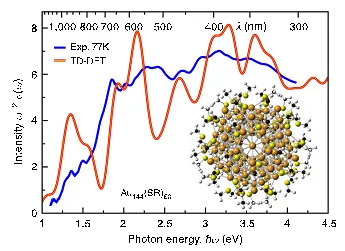P50: When plasmonics meets catalysis: plasmon-enhanced water splitting on gold nanoparticles
Additional Supervisor: Professor Roberto D’Agosta (UPV/EHU, ETSF-NanoBio, Department of Chemistry)
Project Abstract
Plasmonic nanoparticles (PNPs) are widely used in many different technological applications ranging from nanomedicine to biosensing. Recently Au PNPs have been proposed as a source of energetic electrons excited via surface plasmons, and efficient photocatalytic properties in the field of solar energy, energy harvesting and conversion by splitting of water and hydrogen molecules, and thus hydrogen production for clean energy generation [1]. PNP’s surface plasmon is a collective oscillation of electrons induced by resonant photon at a wavelength that depends on the chemical composition and geometry of a nanoparticle. Since gold, silver and aluminium exhibit the resonance in the UV and visible regime, they are of particular interest for solar energy conversion.
Understanding the performance of plasmonic nanostructures for water splitting will require an atomistic investigation of geometrical and electronic structure versus PNP size and chemical composition using both standard and time-dependent density functional method (DFT and TD-DFT). Indeed it has been recently observed that the geometry might play a fundamental role in determining the features of the spectrum (e.g. the frequency of the localised surface plasmon) [2,3]. The initial modelling results will provide a roadmap for planning experiments in Professor Zayats' group, and, in turn, specific experimental configurations will be modelled to provide understanding of experimental results. The PhD advisors, Dr Francesca Baletto and Professor Anatoly Zayats, are experts in the study of heterogeneous catalysis and in nanoplasmonics, respectively.
Project Aims
The first objective was the determination of the chemisorption maps and activation energy barrier of water molecules upon Au clusters at different sizes and geometries [4] using nudged elastic band, and/or dimer methods. The possibility to use metadynamics was investigated. This part of the project benefited from the support of the EPSRC Critical Mass TOUCAN team of which Francesca Baletto is a member. It was then to be asked to calculate the spectra by means of TD-DFT part of the project will be done in collaboration with the ETSF group at EPV/UHV in San Sebastian, Spain, (Professors A. Rubio and R. D’Agosta). At the same time, the candidate had the chance to collaborate directly with Anatoly Zayats’s experimental group. They were able to understand how plamosnic nanoparticles are fabricated and how to analyse experimental measurements. This put the candidate in an ideal position for comparing theoretical predictions with experimental data and proposing an optimal computational strategy and understanding the physic-chemical properties of plasmonic nanoparticles in details.
References
- Mukherjee, et al. Nano Letters (2013) 13, 240; S. Mukherjee, et al., J. Am. Chem. Soc. (2014) 136, 64-67; S. Lunic et al. Nature Materials (2011) 10, 911
- H.CH. Weissker, et al. Nature Communications, (2014) 5, 3785
- B.Y., Zheng et al. Nature Communications, (2015) 6,7797
- F. Baletto and R. Ferrando, Rev. Mod. Phys. (2005) 77. 371

